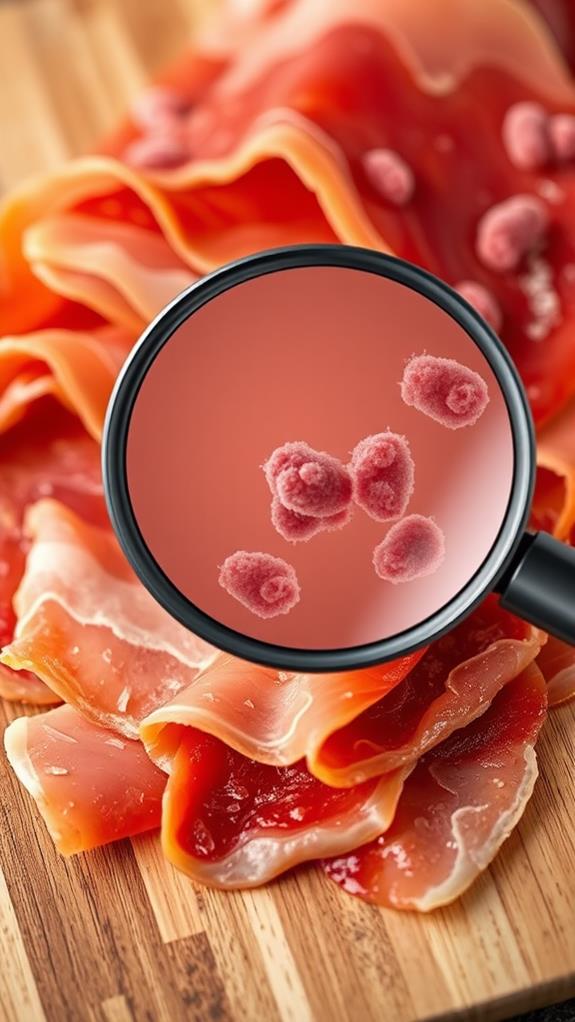Is Prosciutto Safe to Eat
Prosciutto is generally safe to eat when properly produced and handled. The dry-curing process creates an environment that inhibits harmful bacterial growth, ensuring food safety. However, there are potential risks, particularly for pregnant women and immunocompromised individuals, due to the small chance of bacterial contamination. To enjoy prosciutto safely, store it in the refrigerator at 35°F to 40°F and consume within 3-4 days of opening. Cooking prosciutto briefly can enhance flavor and texture while further reducing any potential risks. If you're pregnant or have health concerns, it's best to consult with your healthcare provider before indulging in this Italian delicacy. Exploring the intricacies of prosciutto production and storage can further enhance your appreciation and safe consumption of this beloved cured meat.
This post may contain affiliate links. If you make a purchase through these links, I may earn a commission at no additional cost to you. Additionally, portions of this post may be generated using artificial intelligence (AI) technology. While we strive for accuracy, please be aware that AI-generated content may not always be perfect and should be fact-checked when necessary.
The Spatula Scoops
- Prosciutto is generally safe to eat due to its dry-curing process, which inhibits bacterial growth.
- Strict hygiene standards and quality control measures are implemented during production to ensure safety.
- Proper storage and consumption within recommended timeframes further reduce potential health risks.
- Pregnant women and immunocompromised individuals should exercise caution due to potential bacterial contamination risks.
- Cooking prosciutto briefly can enhance safety, but it's typically consumed raw without significant health concerns for most people.
Understanding Prosciutto Production

Picture a rustic Italian farmhouse where the art of prosciutto-making has been perfected over centuries. This dry-cured ham, a staple of Italian cuisine, undergoes a meticulous production process that guarantees its distinct flavor and texture. Much like safe rabbit meat, prosciutto's safety relies on proper handling and preparation techniques. You'll find that prosciutto production begins with selecting high-quality pork legs, typically from specially bred pigs. The meat is then generously salted and left to rest for several weeks, allowing the salt to draw out moisture and begin the preservation process.
After the initial salting, the ham is washed and hung to dry in a controlled environment. This curing phase can last anywhere from several months to several years, depending on the desired flavor profile. During this time, the meat develops its characteristic sweet and savory taste. The long curing process also contributes to prosciutto's food safety, as the salt and dry environment inhibit bacterial growth. Producers carefully monitor temperature and humidity throughout the aging process to achieve ideal results. You'll notice that the final product is thinly sliced, revealing a rosy-pink color with delicate marbling, ready to be enjoyed as is or incorporated into various dishes.
Curing Process and Safety Measures
Delving into the curing process, you'll find that prosciutto's safety is intrinsically linked to its production methods. The curing process involves salting the pork leg and allowing it to dry for several months, sometimes up to two years. This method, known as dry-curing, creates an environment inhospitable to harmful bacteria, ensuring the meat's safety. Similar to turkey preparation, where carryover cooking plays a pivotal role in reaching safe temperatures, the extended curing time for prosciutto contributes greatly to its safety profile.
During curing, producers carefully monitor temperature and humidity levels. They'll use climate-controlled rooms to maintain preferred conditions, typically keeping temperatures between 55°F and 65°F with humidity levels around 60-80%. These precise environmental controls are indispensable for preventing spoilage and ensuring food safety.
You'll also find that prosciutto producers adhere to strict hygiene standards and quality control measures. They'll regularly inspect the meat for any signs of contamination or improper curing. Many producers use HACCP (Hazard Analysis and Critical Control Points) systems to identify and manage potential food safety risks throughout the production process.
It's worth noting that in the EU and US, prosciutto production is regulated by food safety authorities. These agencies enforce guidelines for safe curing practices, ensuring that the prosciutto you consume meets rigorous safety standards.
Potential Health Risks

While the curing process substantially reduces health risks, it is important to understand that prosciutto isn't entirely risk-free. As with any uncooked meat product, there's a small chance of bacterial contamination, particularly if the prosciutto hasn't been properly stored or handled. You should be aware of these potential health risks:
- Listeria monocytogenes: This bacteria can survive in cold temperatures and may cause listeriosis, a serious infection.
- Toxoplasmosis: A parasitic infection that can be particularly dangerous for pregnant women and those with weakened immune systems.
- Sodium overload: Prosciutto is high in salt, which may be a concern for individuals with hypertension or heart conditions.
It is imperative to purchase prosciutto from reputable sources and follow proper storage guidelines. Keep it refrigerated and consume it within a few days of opening. Similar to cooked chicken, prosciutto should not be left at room temperature for extended periods. The danger zone for bacterial growth applies to cured meats as well, so maintaining proper food safety practices is absolutely essential. If you're pregnant, immunocompromised, or have specific health concerns, consult your healthcare provider before consuming prosciutto. While these risks are relatively low for most people, it is always better to err on the side of caution. By understanding these potential risks and taking appropriate precautions, you can enjoy prosciutto safely as part of a balanced diet.
Safe Consumption Guidelines
To safely enjoy prosciutto, you'll need to follow proper storage techniques and cooking recommendations. Always store your prosciutto in the refrigerator at 40°F (4°C) or below, and consume it within 3-4 days of opening the package. While prosciutto is typically eaten raw, you can cook it briefly to enhance its flavor and texture, but be careful not to overcook it, as this can make the meat tough and dry.
Proper Storage Techniques
Prosciutto's longevity and safety depend heavily on proper storage techniques. To maintain its quality and prevent foodborne illness, you'll need to follow specific guidelines. When storing prosciutto at home, keep it in the refrigerator at a temperature between 35°F and 40°F. Wrap it tightly in plastic wrap or place it in an airtight container to prevent exposure to air and moisture, which can lead to spoilage.
For paramount freshness and safety, follow these storage recommendations:
- Whole prosciutto: Store in a cool, dry place for up to 6 months.
- Sliced prosciutto: Refrigerate and consume within 2-3 days.
- Vacuum-sealed prosciutto: Refrigerate and use within 2-3 weeks of opening.
If you've purchased pre-sliced prosciutto, it's essential to consume it by the "use by" date on the package. When freezing prosciutto, wrap it tightly in freezer-safe packaging and use within 1-2 months for the best quality. Remember, while freezing extends shelf life, it may affect the texture and flavor. Always thaw frozen prosciutto in the refrigerator, never at room temperature, to maintain food safety standards.
Cooking Recommendations
For safe consumption of prosciutto, it's vital to understand proper cooking recommendations. While prosciutto is often enjoyed raw, you can incorporate it into cooked dishes for added flavor and safety. When cooking prosciutto, remember that it's already cured and doesn't require long cooking times. You'll want to heat it just enough to enhance its taste without making it tough or chewy.
| Method | Temperature | Cooking Time |
|---|---|---|
| Pan-frying | Medium-high | 1-2 minutes per side |
| Oven-baking | 375°F (190°C) | 5-7 minutes |
| Grilling | Medium-high | 30-60 seconds per side |
| Wrapping | Varies | Follow recipe instructions |
| Microwaving | High | 10-15 seconds |
When using prosciutto in recipes, add it towards the end of cooking to prevent overcooking. It's perfect for wrapping around vegetables or meats, adding to pizzas, or crisping up as a salad topping. Remember, prosciutto's delicate flavor can be easily overwhelmed, so use it sparingly in dishes. By following these cooking recommendations, you'll guarantee your prosciutto remains safe to eat while maximizing its delicious taste and texture.
Pregnancy and Prosciutto

Pregnant women face three key concerns when it comes to eating prosciutto. These include foodborne illnesses, high sodium content, and potential contamination. While prosciutto is typically safe for most people, pregnancy changes the risk factors.
During pregnancy, your immune system is suppressed, making you more susceptible to infections. Listeria, a bacteria that can be present in cured meats, poses a particular threat. It's imperative to recognize the risks and take necessary precautions.
Three important points to weigh:
- Raw or undercooked prosciutto can harbor harmful bacteria
- Heating prosciutto to 165°F (74°C) can reduce the risk of foodborne illness
- Prosciutto's high salt content may contribute to pregnancy-related health issues
If you're craving prosciutto during pregnancy, you're not alone. However, it's vital to prioritize your health and your baby's well-being. Contemplate alternatives like cooked ham or thoroughly heated prosciutto. Always consult your healthcare provider for personalized advice on your diet during pregnancy. They can help you make informed decisions based on your specific health needs and risk factors.
Storing and Handling Prosciutto
When storing prosciutto, you'll want to focus on proper refrigeration techniques and avoiding cross-contamination risks. Keep your prosciutto wrapped tightly in plastic or stored in an airtight container in the refrigerator, ideally at temperatures between 35°F and 40°F (1.7°C to 4.4°C). To prevent cross-contamination, always use clean utensils and cutting boards when handling prosciutto, and store it separately from raw meats and other ready-to-eat foods.
Proper Refrigeration Techniques
Proper refrigeration is essential for maintaining the quality and safety of prosciutto. You'll want to store your prosciutto in the coldest part of your refrigerator, typically the back of the bottom shelf. Keep the temperature between 35°F and 40°F (1.7°C to 4.4°C) to slow bacterial growth and preserve flavor. If you've purchased pre-sliced prosciutto, it's best to consume it within 3-5 days of opening the package.
For whole prosciutto legs or larger pieces, follow these steps:
- Wrap the prosciutto tightly in plastic wrap or butcher paper to prevent air exposure.
- Place the wrapped prosciutto in an airtight container or resealable plastic bag.
- Store in the refrigerator for up to two weeks, checking regularly for any signs of spoilage.
Avoiding Cross-Contamination Risks
To prevent cross-contamination when storing and handling prosciutto, you'll need to follow some key practices. Always store your prosciutto in a sealed container or tightly wrapped in plastic wrap or aluminum foil. Place it on the bottom shelf of your refrigerator to prevent any juices from dripping onto other foods. It's imperative to use separate cutting boards and utensils for prosciutto and other ready-to-eat foods.
When handling prosciutto, wash your hands thoroughly before and after touching it. Don't let raw meats or poultry come into contact with your prosciutto, as this can transfer harmful bacteria. If you're slicing prosciutto, clean and sanitize your slicer between uses, especially if you've used it for other meats. When serving, use clean plates and utensils dedicated to the prosciutto.
Be mindful of the "danger zone" – temperatures between 40°F and 140°F where bacteria multiply rapidly. Don't leave prosciutto out at room temperature for more than two hours. If you're hosting a party, consider serving small portions and replenishing as needed to maintain food safety. By following these guidelines, you'll minimize the risk of cross-contamination and keep your prosciutto safe to eat.
Frequently Asked Questions
Can Prosciutto Be Used as a Substitute for Bacon in Recipes?
You can use prosciutto as a bacon substitute in many recipes, but it's crucial to recognize the differences. Prosciutto is thinner and has a more delicate flavor than bacon. It's best employed in dishes where it won't be cooked for long periods, as it can become tough. Try wrapping it around asparagus, adding it to salads, or using it as a pizza topping. Keep in mind that prosciutto is saltier than bacon, so you might need to adjust your seasoning accordingly.
How Does Prosciutto Compare Nutritionally to Other Cured Meats?
Did you know that prosciutto contains about 18 grams of protein per 100-gram serving? When comparing prosciutto to other cured meats, you'll find it's generally lower in fat and calories than bacon or salami. It's also higher in sodium, like most cured meats. Prosciutto offers more protein per ounce than many alternatives, making it a good choice for those watching their macronutrients. However, it's still high in saturated fat, so you should consume it in moderation.
Are There Different Varieties of Prosciutto From Various Regions?
Yes, there are different varieties of prosciutto from various regions. You'll find that Italy boasts numerous regional types, each with unique characteristics. Prosciutto di Parma and Prosciutto di San Daniele are two well-known varieties, but there are others like Prosciutto Toscano and Prosciutto di Modena. Outside Italy, you'll encounter Spanish jamón and German Black Forest ham, which are similar cured meats. Each variety has its own distinct flavor profile, influenced by factors such as climate, curing methods, and pig breeds used.
Can Prosciutto Be Frozen for Long-Term Storage?
You've got a prosciutto predicament, huh? Well, you'll be relieved to know that you can indeed freeze prosciutto for long-term storage. While it's best enjoyed fresh, freezing is a viable option if you've got more than you can handle. Wrap it tightly in plastic wrap or aluminum foil, then place it in an airtight container or freezer bag. It'll keep for up to two months. When you're ready to use it, thaw it in the refrigerator overnight for the best results.
What Are Some Popular Wine Pairings for Prosciutto?
When pairing wine with prosciutto, you'll find several options that complement its salty, rich flavor. Light-bodied reds like Pinot Noir or Beaujolais work well, enhancing the meat's delicate taste. If you prefer white wine, try a crisp Prosecco or Champagne to cut through the prosciutto's fattiness. For a bolder choice, consider a medium-bodied Sangiovese or Chianti. Don't forget about rosé; its acidity and fruitiness can balance the prosciutto's saltiness perfectly.
Conclusion
You've learned that prosciutto, when properly produced and handled, is generally safe to eat. However, it's vital to be aware of potential risks, especially for certain groups like pregnant women. Remember, "all that glitters isn't gold," so always purchase from reputable sources and follow safe storage practices. By understanding the production process, potential health concerns, and proper consumption guidelines, you can enjoy this delicacy with confidence. Always consult your doctor if you have specific health concerns.





